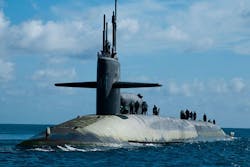Officials of the Naval Undersea Warfare Center (NUWC) Newport in Middletown, R.I., announced a $44.7 million contract to L-3 KEO on Thursday for depot-level upgrade, repair, and overhaul of the fiber-optic periscopes, which are called photonics masts.
L-3 KEO will repair and upgrade the Navy's AN/BVS-1 Photonics Mast and AN/BVS-1(V) Photonics Mast Variant, which are major units within the imaging systems on Virginia-class and Ohio-class submarines, Navy officials say.
The AN/BVS-1 Photonics Mast is a non-hull penetrating electronic imaging subsystem with visible light camera, infrared camera, and electronic support measures sensors, as well as stealth features that will provide new capabilities for attack submarines, Navy officials say.
Related: Not your grandfather's submarine periscope
The Photonics Mast Variant is a derivative of the AN/BVS-1 Photonics Mast fitted to the Navy's Ohio-class submarines that are adapted to carry long-range cruise missiles, rather than nuclear-tipped ballistic missiles.
A photonics mast is different from a traditional submarine optical periscope in that the photonics mast does not penetrate into the submarine's hull. Instead, it rises in a telescoping motion, similar to a car antenna. Sensors on the photonics mast interface to a remote-control console aboard the submarine.
Output from the Photonics Mast goes to sophisticated computer workstations, and is networked throughout the submarine. Each Virginia-class submarine will have two AN/BVS-1 Photonics Masts. Using a non-penetrating electro-optical system, rather than an optical periscope, gives submarine designers flexibility in locating the vessel's sail, as well as in the boat's interior layout.
Sensors mounted on the Photonics Mast include low-light television (LLTV), thermal imager, and laser rangefinder. The Photonics Mast and Photonics Mast Variant are components of the Navy's Universal Modular Mast developed by Kollmorgen and its Italian subsidiary, Calzoni.
Related: Lockheed Martin to upgrade electro-optical imaging systems for Navy submarine fleet
Thursday contract calls for L-3 KEO to provide repair masts; replace and repair mast subassemblies; testing, inspection, and evaluation of photonics masts; and upgrade the Photonics Mast and Photonics Mast Variant. The company also will provide field engineering and technical support at intermediate-level repair facilities.
The submarine sensor suite on the Universal Modular Mast performs surveillance, intelligence gathering, and electronic warfare, with a multispectral suite of a color and a monochrome high-definition TV cameras, a midwave infrared staring sensor, eye-safe laser rangefinder, as RF sensors.
The system brings infrared search and track (IRST) capabilities such as infrared and visual imaging, and digital image processing. A modified AN/BVS-1(V) is being developed for the Integrated Submarine Imaging System (ISIS) on Ohio-class guided-missile submarines as a replacement for the type 15L periscope.
On this contract L-3 KEO will do the work in Northampton, Mass., and should be finished by January 2019. For more information contact L-3 KEO online at www2.l-3com.com/keo, or the Naval Undersea Warfare Center Newport at www.navsea.navy.mil/Home/WarfareCenters/NUWCNewport.



